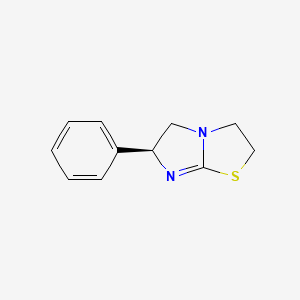



1. Decaris
2. Dekaris
3. Hydrochloride, Levamisole
4. L-tetramisole
5. Levamisole Hydrochloride
6. Levotetramisole
7. Solaskil
1. 14769-73-4
2. Levamisol
3. L-tetramisole
4. Ketrax
5. Wormicid
6. Lepuron
7. Levomysol
8. Levamisolum
9. (s)-6-phenyl-2,3,5,6-tetrahydroimidazo[2,1-b]thiazole
10. Levamisol [inn-spanish]
11. Levamisolum [inn-latin]
12. (-)-tetramisole
13. (6s)-6-phenyl-2,3,5,6-tetrahydroimidazo[2,1-b][1,3]thiazole
14. (s)-(-)-levamisole
15. Tcmdc-125847
16. Vermisol 150
17. Dl-tetramisole
18. L-tetramisol
19. Levamisole (inn)
20. Tetramisole, (s)-
21. (6s)-6-phenyl-2h,3h,5h,6h-imidazo[2,1-b][1,3]thiazole
22. Imidazo(2,1-b)thiazole, 2,3,5,6-tetrahydro-6-phenyl-, (s)-
23. Chembl1454
24. Chebi:6432
25. (6s)-6-phenyl-2,3,5,6-tetrahydroimidazo[2,1-b]thiazole
26. 14769-73-4 (free Base)
27. Levamisole [inn]
28. Imidazo[2,1-b]thiazole, 2,3,5,6-tetrahydro-6-phenyl-, (6s)-
29. 2880d3468g
30. Levamisole [inn:ban]
31. Levovermax
32. Totalon
33. 49548-36-9
34. L-2,3,5,6-tetrahyro-6-phenylimidazo(2,1-b)thiazole
35. Imidazo(2,1-b)thiazole, 2,3,5,6-tetrahydro-6-phenyl-, (6s)-
36. (-)-tetramisole Hydrochloride
37. L(-)-levamisole
38. Ketrax (tn)
39. Nsc177023
40. Einecs 238-836-5
41. Mfcd00792481
42. Unii-2880d3468g
43. Levamisol 100 Microg/ml In Acetonitrile
44. (-)-levamisole
45. Spectrum_001609
46. Levamisole [mi]
47. (s)-(-)-tetramisole
48. Prestwick0_000182
49. Prestwick1_000182
50. Prestwick2_000182
51. Spectrum2_000865
52. Spectrum3_000962
53. Spectrum4_001078
54. Spectrum5_001645
55. Levamisole [vandf]
56. P00039
57. Levamisole [mart.]
58. (-)-6-phenyl-2,3,5,6-tetrahydroimidazo[2,1-b]thiazole
59. (s)-2,3,5,6-tetrahydro-6-phenylimidazo[2,1-b]thiazole
60. Levamisole [who-dd]
61. Lopac0_000690
62. Schembl19227
63. Bspbio_002563
64. Kbiogr_001436
65. Kbioss_002089
66. Cid_68628
67. Bidd:gt0372
68. Divk1c_000667
69. Spbio_000909
70. Spbio_002024
71. Gtpl7210
72. Levamisole [green Book]
73. Dtxsid4023206
74. Kbio1_000667
75. Kbio2_002089
76. Kbio2_004657
77. Kbio2_007225
78. Kbio3_001783
79. Ninds_000667
80. Hms2090o04
81. Zinc119839
82. Hy-a0106
83. Bdbm50241179
84. Dl-429
85. Levamisol 100 Microg/ml In Methanol
86. Akos001637203
87. Ccg-204775
88. Cs-w009271
89. Db00848
90. Ds-4066
91. Sdccgsbi-0050668.p004
92. Idi1_000667
93. Ncgc00162225-02
94. Ncgc00162225-03
95. Ncgc00162225-04
96. Ncgc00162225-05
97. Ncgc00162225-08
98. Ncgc00162225-14
99. Ac-18929
100. Nci60_001476
101. Sbi-0050668.p003
102. C07070
103. C72809
104. D08114
105. Ab00053661-07
106. Ab00053661-08
107. Ab00053661_09
108. Ab00053661_10
109. A808675
110. Q417097
111. Brd-k73107279-003-03-4
112. 2,3,5,6-tetrahydro-6-phenyl-imidazo[2,1-b]thiazole, (s)-
113. (-)-6-phenyl-2,3,5,6-tetrahydroimidazo[2,1-b][1,3]thiazole
114. 6-phenyl-2,3,5,6-tetrahydro-imidazo[2,1-b]thiazole (levamisole)
115. 6-phenyl-2,3,5,6-tetrahydro-imidazo[2,1-b]thiazole(levamisole)
116. 6-phenyl-2,3,5,6-tetrahydro-imidazo[2,1-b]thiazole(tetramisole)
117. Levamisole;6-phenyl-2,3,5,6-tetrahydro-imidazo[2,1-b]thiazole
118. Tetramisole;6-phenyl-2,3,5,6-tetrahydro-imidazo[2,1-b]thiazole
119. (-)-levamisole Hydrochloride Solution, 1.0 Mg/ml In Methanol (as Free Base), Ampule Of 1 Ml, Certified Reference Material
| Molecular Weight | 204.29 g/mol |
|---|---|
| Molecular Formula | C11H12N2S |
| XLogP3 | 1.8 |
| Hydrogen Bond Donor Count | 0 |
| Hydrogen Bond Acceptor Count | 2 |
| Rotatable Bond Count | 1 |
| Exact Mass | 204.07211956 g/mol |
| Monoisotopic Mass | 204.07211956 g/mol |
| Topological Polar Surface Area | 40.9 Ų |
| Heavy Atom Count | 14 |
| Formal Charge | 0 |
| Complexity | 246 |
| Isotope Atom Count | 0 |
| Defined Atom Stereocenter Count | 1 |
| Undefined Atom Stereocenter Count | 0 |
| Defined Bond Stereocenter Count | 0 |
| Undefined Bond Stereocenter Count | 0 |
| Covalently Bonded Unit Count | 1 |
For adjuvant treatment in combination with fluorouracil after surgical resection in patients with Dukes' stage C colon cancer. Also used to treat malignant melanoma and head/neck cancer.
Levamisole is a synthetic imidazothiazole derivative that has been widely used in treatment of worm infestations in both humans and animals. As an anthelmintic, it probably works by targeting the nematode nicotinergic acetylcholine receptor. As an immunomodulator, it appears that Levamisole is an immunostimulant which has been shown to increase NK cells and activated T-cells in patients receiving this adjuvantly along with 5FU for Stage III colon cancer.
Adjuvants, Immunologic
Substances that augment, stimulate, activate, potentiate, or modulate the immune response at either the cellular or humoral level. The classical agents (Freund's adjuvant, BCG, Corynebacterium parvum, et al.) contain bacterial antigens. Some are endogenous (e.g., histamine, interferon, transfer factor, tuftsin, interleukin-1). Their mode of action is either non-specific, resulting in increased immune responsiveness to a wide variety of antigens, or antigen-specific, i.e., affecting a restricted type of immune response to a narrow group of antigens. The therapeutic efficacy of many biological response modifiers is related to their antigen-specific immunoadjuvanticity. (See all compounds classified as Adjuvants, Immunologic.)
Antirheumatic Agents
Drugs that are used to treat RHEUMATOID ARTHRITIS. (See all compounds classified as Antirheumatic Agents.)
Antinematodal Agents
Substances used in the treatment or control of nematode infestations. They are used also in veterinary practice. (See all compounds classified as Antinematodal Agents.)
P - Antiparasitic products, insecticides and repellents
P02 - Anthelmintics
P02C - Antinematodal agents
P02CE - Imidazothiazole derivatives
P02CE01 - Levamisole
Absorption
Levamisole is rapidly absorbed (2 hours) from the gastrointestinal tract.
Primarily hepatic (extensive) with both active and inactive metabolites.
4.4-5.6 hours (biphasic)
The mechanism of action of levamisole as an antiparasitic agent appears to be tied to its agnositic activity towards the L-subtype nicotinic acetylcholine receptors in nematode muscles. This agonistic action reduces the capacity of the males to control their reproductive muscles and limits their ability to copulate. The mechanism of action of Levamisole as an anticancer drug in combination with fluorouracil is unknown. The effects of levamisole on the immune system are complex. The drug appears to restore depressed immune function rather than to stimulate response to above-normal levels. Levamisole can stimulate formation of antibodies to various antigens, enhance T-cell responses by stimulating T-cell activation and proliferation, potentiate monocyte and macrophage functions including phagocytosis and chemotaxis, and increase neutrophil mobility, adherence, and chemotaxis.